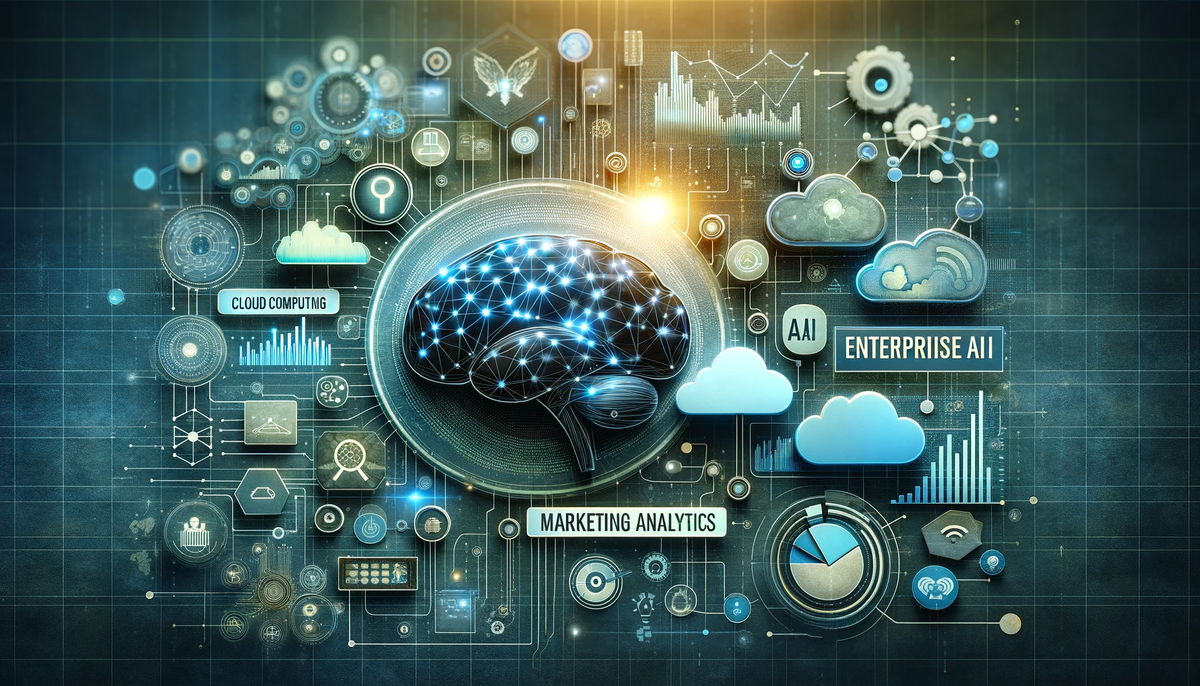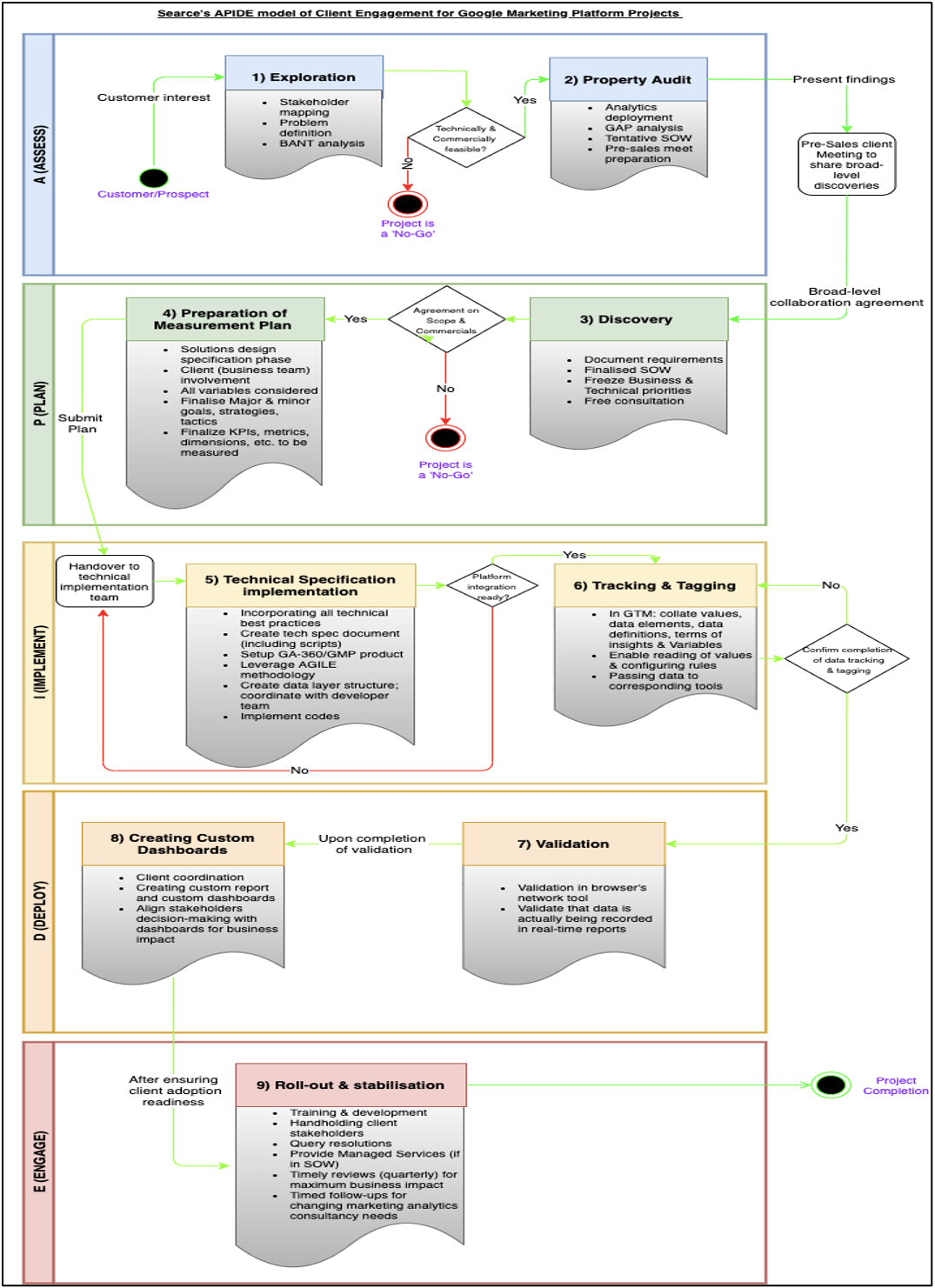Pioneering Marketing Tech in the AI Era: My Personal Journey
Delve into the fusion of Enterprise AI and Marketing Analytics. This insightful article offers a deep dive into how AI is reshaping marketing strategies, driving digital innovation, and creating transformative business solutions in various industries.

Introduction: A Turning Point in Early 2020
The year 2020 marked a significant turning point in my life. After accepting an acquisition offer for my EdTech startup, Skill Academy, I found myself at a crossroads during the onset of the Covid-19 pandemic. Initially relishing the break, I soon felt the urge to dive back into the professional world, but the constraints of a 7-year non-compete clause and a shifting startup landscape, now demanding 'Covid-proof' ideas, led me to reconsider my options. It was then that I encountered Searce and embarked on a transformative journey into the realm of Enterprise AI.
The Emergence of Enterprise AI
In 2021, when I joined as the Head of Marketing Analytics Practice at Searce, the Enterprise AI market was flourishing, valued at $64.5 billion and projected to grow at a CAGR of 35% until 2030. While retail AI has been in the news sharply recently, there is a whole another world of Enterprise AI which works behind the scenes to serve customers from the vehicles of respective organisations. In this article, I will try and unpack and unravel the world of Enterprise AI.
The Enterprise AI industries 3 largest markets are North America, Europe followed by Asia Pacific. The early focus was on migrating data from on-premise solutions to cloud platforms led by giants like Google, AWS, Microsoft, Oracle, IBM and others. My role involved leveraging these technologies to deliver innovative solutions across the Asia-Pacific region.
Disruptive Technologies in Enterprise AI
The evolution of enterprise AI, with its disruptive technologies, paralleled the advancements in retail AI, led by innovations like ChatGPT, Claude, and Gemini. Previously, companies were content with simple online sales options, now seen as outdated as bullock-carts compared to self-driving cars. My work has allowed me to witness digital transformation across industries. For instance, automobile manufacturers now offer virtual test drives and feature explorations on their apps and websites for home-based user experiences. Customers demand a seamless interaction with the brand of their choice on their App, Website via any of their social media handles. And they expect install recall of past records to be able to query a solution to their present problems.
The transition from basic online sales options to sophisticated, omni-channel marketing strategies underscored the necessity for brands to adopt technologies like data lakes, recommendation engines, and forecasting models. These tools were crucial in delivering seamless customer experiences across various digital platforms, turning 'adapt or die' into the new business mantra for companies as the competition also suited up their digital properties into the Enterprise AI armour.
Transformative Client Experiences: The Travel Platform Case Study
A notable project during my tenure involved a leading Indian travel booking platform. Our goal was to enhance the relevance and usability of their online properties. The comprehensive solution utilized Google Maps APIs and BigQuery to revamp their digital experience. It also involved creating a Marketing Data Warehouse and charting user journeys and analysing paths of maximum drop-offs and redesigning entire web-pages and App screens. The impact was immediate and drastic, resulting in efficient hotel and bus booking processes, reduced queuing times, and a significant 25% increase in Net Promoter Score.
For the customer, the metrics that mattered had swung in favourable directions. Behind the scenes, my team had worked tirelessly setting up the nuts and bolts of the enterprise AI architecture: Firebase, Firebase Realtime Database, Google Maps Platform, Google Places API, G Suite, Sheets, Drive, BigQuery, Google Analytics-360, Cloud vision API. As they say, "Success is built on a foundation of multiple building blocks, each one a stepping stone to greater achievements."
How Customers Verbalise their Needs for Marketing Tech
The successful implementation of these solutions required meticulous setup of an Enterprise AI architecture, involving tools like Firebase, Google Maps Platform, G Suite, BigQuery, and Google Analytics-360. This six-month journey of understanding and applying these technologies was akin to solving a complex jigsaw puzzle, albeit one that continuously evolved with each new challenge.
Clients often approach us seeking to elevate their businesses. They ask, "How can we scale our marketing efforts to match our business growth?" and "What strategies can increase our online visibility and sales?" Their inquiries range from enhancing marketing ROI to understanding campaign performance, integrating data across platforms like Facebook, Instagram, Twitter, and Google Ads, and resolving issues in Google Analytics. Challenges include tracking specific events, automating sales funnels, analyzing user behavior in apps, and applying best practices in marketing analytics. One client expressed, "We've deployed Google Analytics, but why doesn't the data match across tools?" Another shared, "We struggle to analyze user behavior in our app – how can we improve this?"
This usually marks the beginning point of a joint journey of problem discovery, scope identification to solution deployment and reaping of the benefits. And it all begins as a joint consulting engagement.
The Consulting Process: Navigating Client Expectations
In the world of Enterprise AI consulting, the focus is often on results. However, the path to these results is rarely linear, involving a discovery process through various frameworks. I regularly engaged with key stakeholders like CMOs, CTOs, and CEOs, addressing a range of questions and challenges, from scaling marketing efforts to integrating campaign data across digital channels.
While everyone wants to either increase revenues or decrease costs, the genesis of discussion often originates to solve particular pain-points of affected parties in the client organisation. The affected parties can be anybody from Marketing manager, Content team, Media agency, IT, Strategy team, Data analysts. The higher-ups usually are simply voicing their pain-points and are looking for a solution.
But since solving the problem is usually a process of discovery of the scope, tech stack requirements which eventually boils down to billable hours and product subscription billing and so is always a touchy subject for the clients. As clients progress through our sales funnel, we gain deeper insights into their tech architecture, products, services, and consumers, positioning us better to address their challenges. To navigate this complexity, I employ various frameworks tailored to the industry, scale, and geography.
A Framework for Success: The APIDE Model
For large-scale BFSI clients in Asia-Pacific, we followed the APIDE (Assess, Plan, Implement, Deploy & Engage) model, a 9-step process encompassing everything from property audits to the creation of custom dashboards and roll-out stabilization. This structured approach ensured that our solutions not only met but exceeded client expectations.
The 9 steps are outlined below:
- Explore
- Property Audit & Assessment
- Plan & Discovery
- Preparation of Measurement Plan
- Technical specification implementation
- Tracking & Tagging
- Validation
- Creating custom dashboards
- Roll-out & stabilisation
The flow-chart below should be able to give a clearer picture of the entire process.

Each of these 9 steps, of course, are further sub-divided into detailed steps themselves involving a combination of several tools and data-points.
The Impact of Enterprise AI on Business Metrics
The implementation of our solutions often resulted in significant improvements in key business metrics. When clients complete the process and we implement the solution, they can enjoy the benefits, though continuous engagement is needed for optimal results. The tools we provide enable them to achieve their goals, such as identifying look-alike audiences on social media for more effective marketing with better conversion rates and lower costs. These strategies improve key metrics like visitor numbers, page views, bounce rates, cart abandonment, sales conversions, and transaction values.
From a purely numerical and business stand-point, typical benefits fall under two buckets:
- Decrease in
- User & customer leakages
- Wasteful marketing spend ($)
- Reliance on expensive sourcing
- Ad-hoc nature of customer acquisition
- Time b/w consecutive campaigns
- Confusion!
- Increase in
- Customer retention (CSAT)
- Revenues ($)
- No. of Transactions
- Marketing ROI
- Online lead generation
- Brand visibility
Industry-Specific Use Cases of Marketing Analytics
Enterprise AI and marketing analytics have widespread applications across various industries. From startups to healthcare, each sector benefits from tailored AI-driven solutions, whether it's enhancing customer engagement in online education or automating sales funnels in real estate.
Below, I've jotted down few use-cases by industry which can help you brainstorm your next data transformation journey into Enterprise AI:
- Startups
- User acquisition & market expansion
- Higher rounds of Fund-raising
- Discovery of new Products & services
- Precise customer profiling
- BFSI
- Enhanced customer profiling
- Real-time Ads bidding
- Personalised customer experience
- Higher Sales
- Online Gaming
- Firmly establish customer intimacy
- Focused Ad campaigns
- Targeted induction of new features/games
- Personalised User Journeys
- Manufacturing
- Automated delivery notifications
- Product-specific sales reports
- Integrated operations & sales planning
- Real-time consumer insights
- Product/Feature intelligence
- Demand forecasting
- Consumer intelligence
- Online Education
- Rapid student acquisition
- Design personalised content
- Enhanced student engagement
- Recommendation Engines
- Fitness & Well-Being
- Detailed Customer profiling
- Integrations
- Custom User Journeys
- Recommendation Engines
- Real Estate
- Leads to Walk-in conversions
- Marketing Automation
- Fully Automated online sales funnels
- Enhanced Custom Profiling
- Healthcare
- Enhanced Brand Awareness
- Build Custom user Journeys
- New Products/Feature development
- High CSAT score
- Automated customer interactions
Conclusion: Embracing the Future of AI
Looking back, the rapid advancement in the Enterprise AI sector is not just a trend but a clear indicator of an accelerated pace of innovation. This realisation fills me not with fear or worry, but with an excitement akin to the anticipation of an uncharted adventure. The future of Enterprise AI promises to continue solving business challenges in increasingly ingenious ways. The key to success will lie in the willingness of enterprise teams to adapt and embrace these changes, ensuring a rewarding journey ahead.




